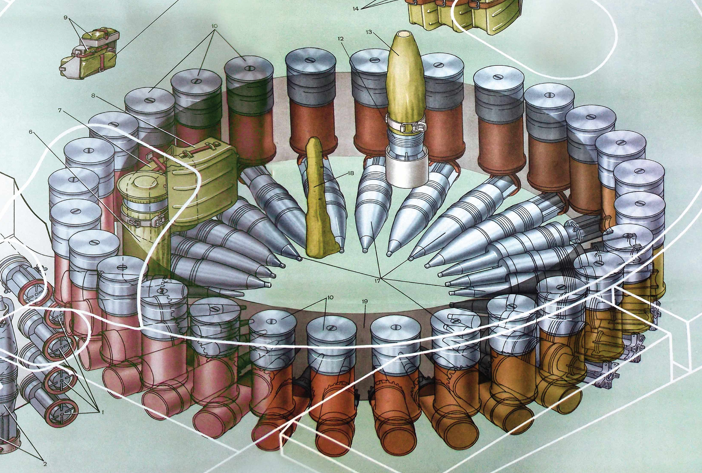(2/17) The vast majority of postwar tanks use some form of torsion bar suspension (notable exceptions: British tanks and Israeli Merkavas). These rely on the twisting ('torsion') of a metal rod ('bar') to absorb the movement of the tank's road wheels over rough ground.
(3/17) It's simple, effective, and compact, so has been the go-to standard for tank suspensions since World War II.
tanknology.co.uk/post/primer-to…
tanknology.co.uk/post/primer-to…
(4/17) In almost every tank with torsion bars, these bars usually span the width of the tank, anchored to the opposite side of the hull from where the road wheel is. This in turn means you need to place the road wheels asymmetrically, as on the Leopard 2. 



(5/17) For the T-64, KhKBM decided to try something different: shorten the torsion bars and fix them to the middle of the tank. In Russian this is sometimes known as соосные торсионы ('coaxial torsion bars'). The T-64's bars are about 55% the length of a T-72's. 



(6/17) The max twist angle of a torsion bar is determined by the allowed shear stress and length of the bar. A shorter bar has to withstand much higher shear stress in order to be able to twist the same amount.
engineeringtoolbox.com/torsion-shafts…
engineeringtoolbox.com/torsion-shafts…
(7/17) The T-64's bars have a stress limit of 1,500 MPa, greater than the T-72/80 (1,300 MPa) or contemporary Leopard 1 (1,050 MPa), allowing them to reach the desired 62° twist angle. This is accomplished via presetting the bars.
btvt.info/4ourarticles/i…
btvt.info/4ourarticles/i…

(8/17) Presetting allows the bars to withstand a much greater stress than normally possible, but means that torsion bars are not interchangeable between the left and right side of the tank.
armor.kiev.ua/Tanks/Modern/T…
btvt.info/4ourarticles/i…


armor.kiev.ua/Tanks/Modern/T…
btvt.info/4ourarticles/i…



(9/17) Although sometimes claimed to be 'fragile', the T-64's torsion bars are, in fact, more durable than the T-72's or T-80's, as confirmed by test results published in the Soviet Bulletin of AFV Technology (1985).
btvt.info/5library/vbtt_…
btvt.info/5library/vbtt_…

(10/17) Tanknology notes that the coaxial configuration results in 'sub-optimal spring characteristics', but does not specify what, so it is unclear to me. 

(11/17) On the plus side, having the wheels placed symmetrically reduces oscillations, improving ride comfort and firing accuracy.
btvt.info/1inservice/t64…
btvt.info/1inservice/t64…

(12/17) This is complemented by the T-64's long balancers (or torsion keys). These have a length of 380 mm, significantly longer than the 250 mm balancers of the T-72. 



(13/17) Basic high school physics and/or practical experience should tell you that the longer your lever is, the easier it will be to rotate the lever (less force), just as it is easier to rotate a nut with a long wrench than with a short wrench. 

(14/17) What applies to the wrench applies just as much to tank balancers, and the result is the T-64 has the least 'stiff' suspension, as shown in the Ukrainian study for deciding on future tank suspension systems. 

(15/17) The T-72 has a notoriously stiff suspension, as demonstrated by Shawshank.
This is because (a) it has short balancers and (b) it uses old vane-style hydraulic shock absorbers.
This is because (a) it has short balancers and (b) it uses old vane-style hydraulic shock absorbers.
(16/17) The T-64 introduced new telescoping hydraulic shock absorbers (left), which are considerably more efficient than the T-72's vane shock absorbers (right), with a higher cut-off force. They were later also adopted for the T-80 in modified form. 





(17/17) In general, the T-64's suspension is very well-optimised for smooth-running on moderately bumpy terrain.
It has vibration problems when running on hard concrete, and it also is more easily damaged in 'flying/jumping' displays, but you can be the judge on their value.
It has vibration problems when running on hard concrete, and it also is more easily damaged in 'flying/jumping' displays, but you can be the judge on their value.
• • •
Missing some Tweet in this thread? You can try to
force a refresh

 Read on Twitter
Read on Twitter


























